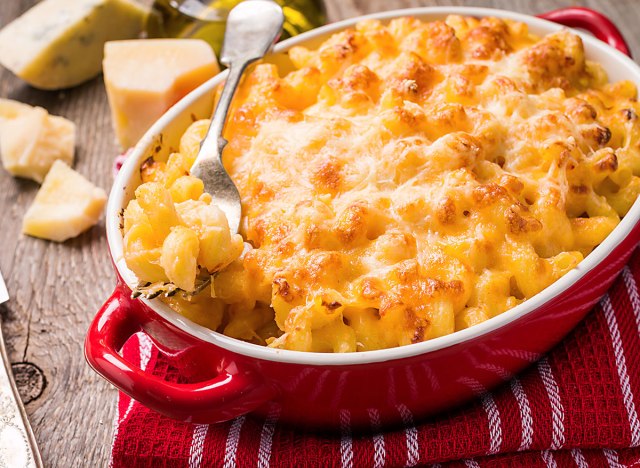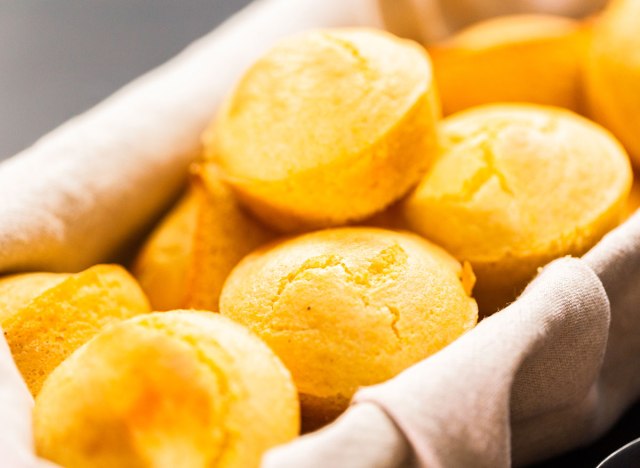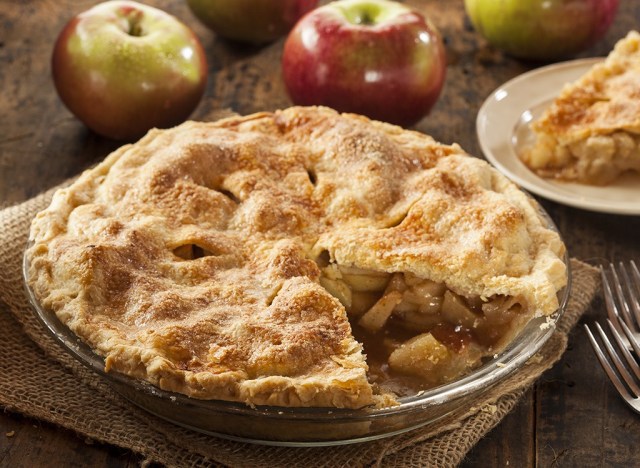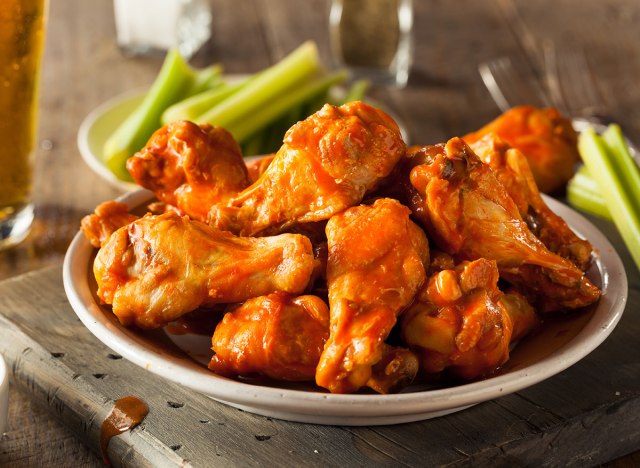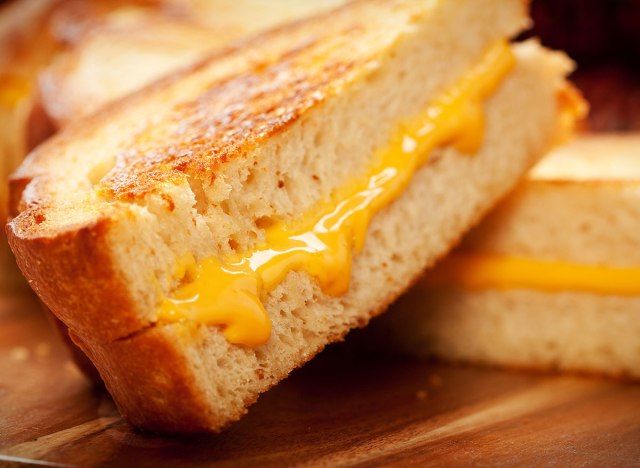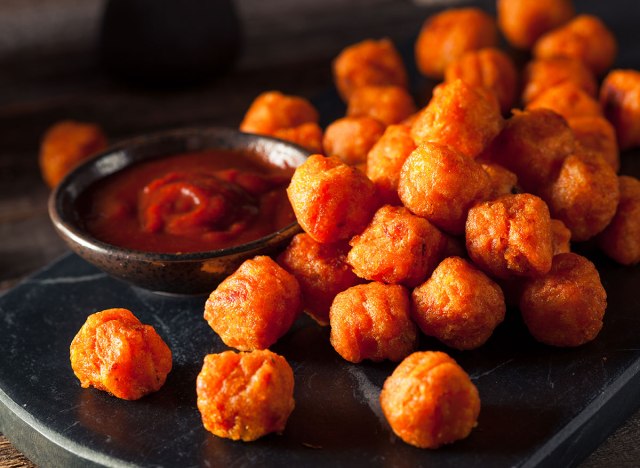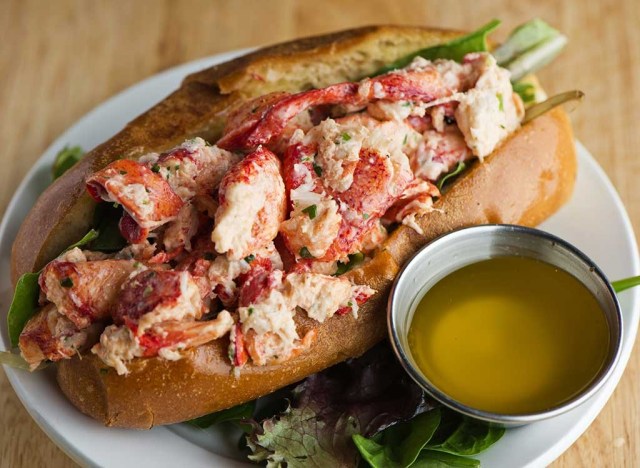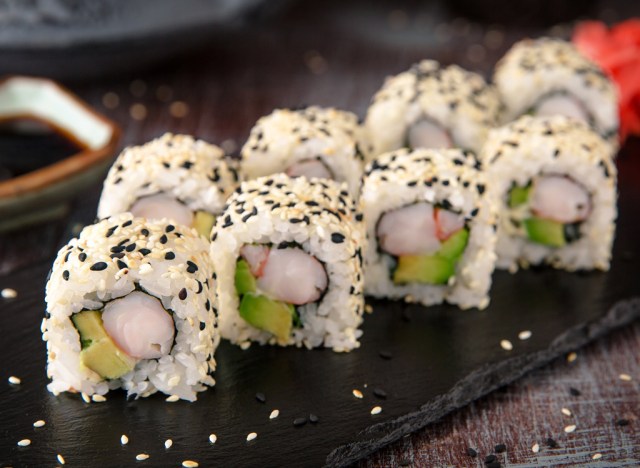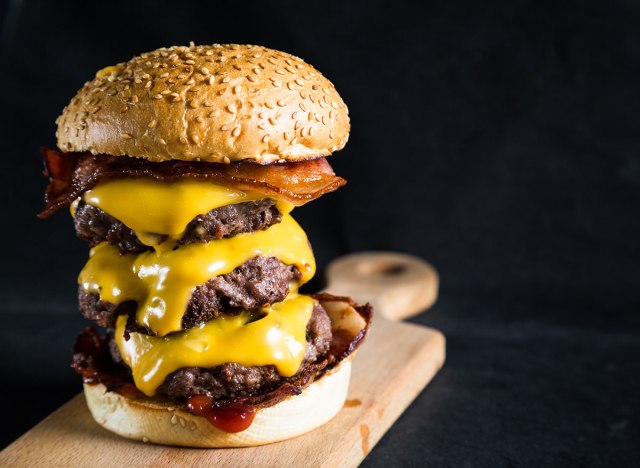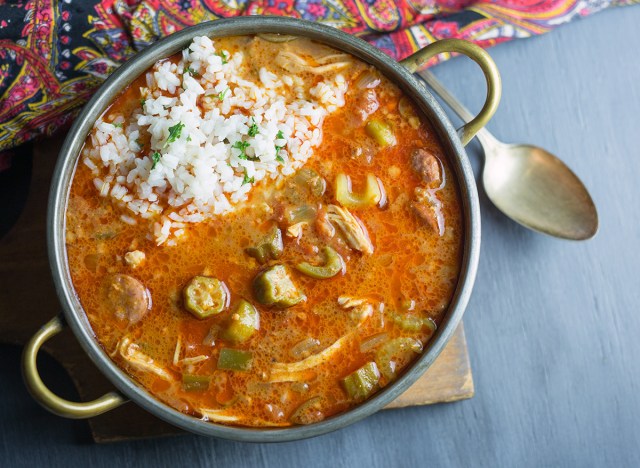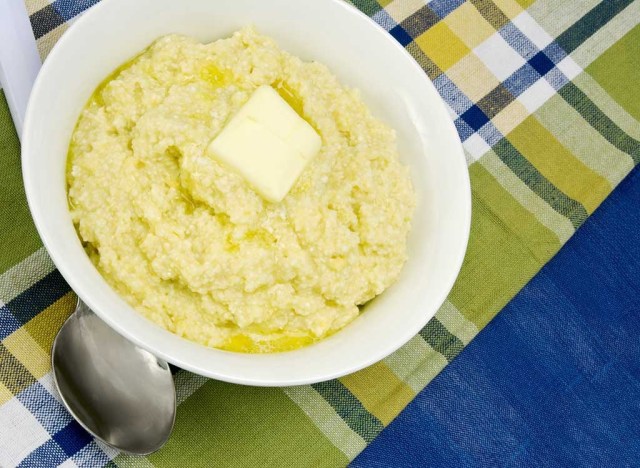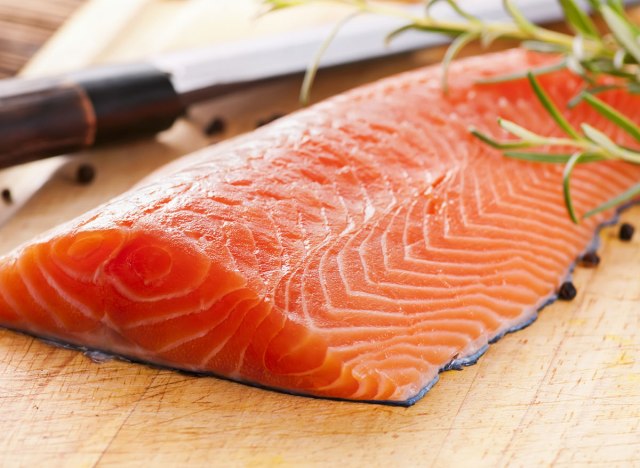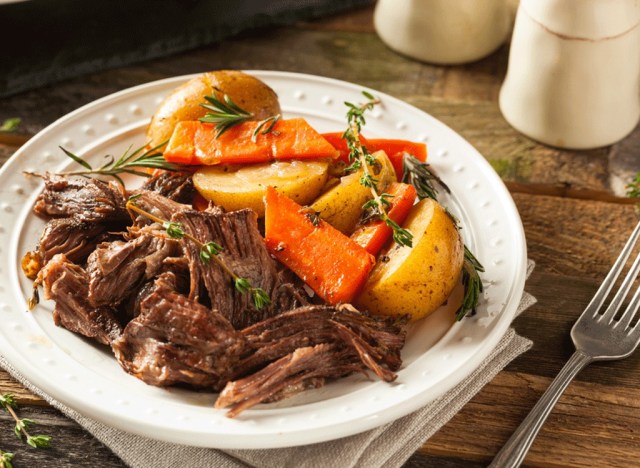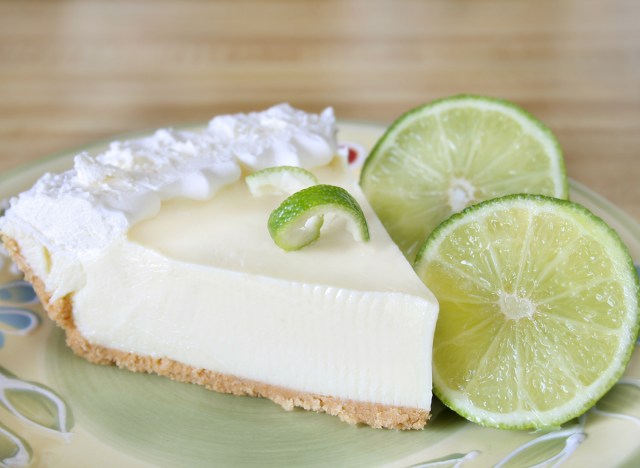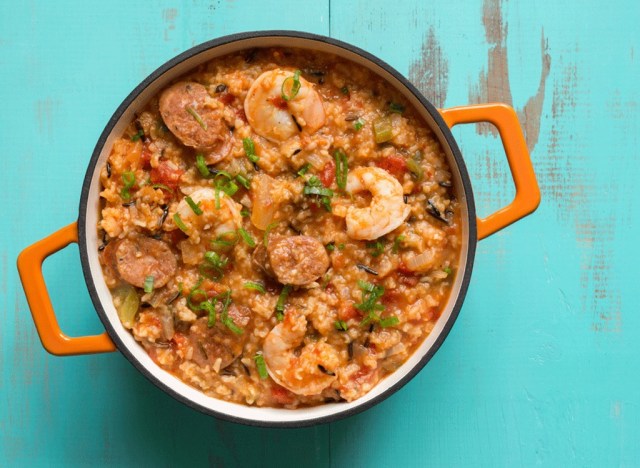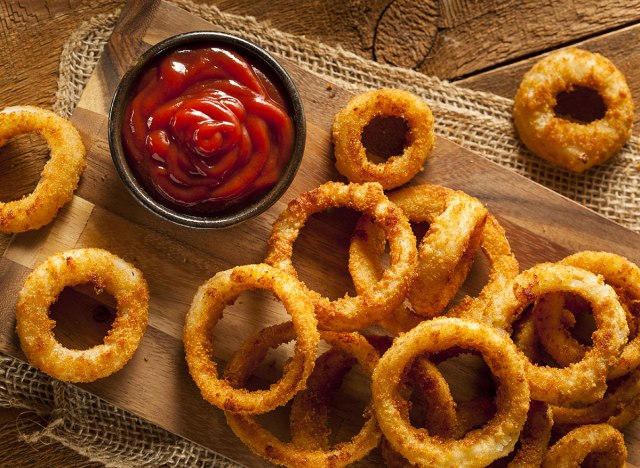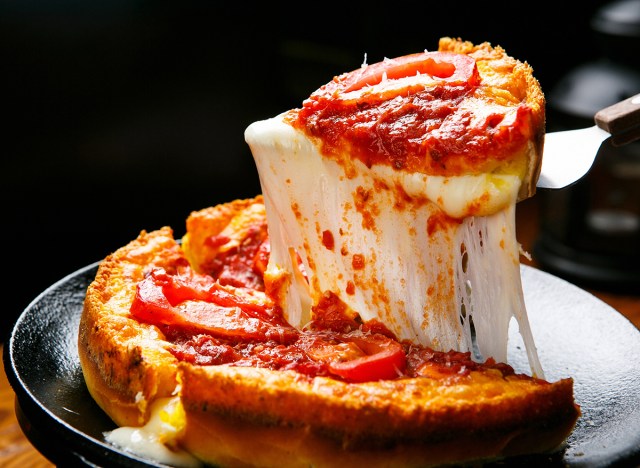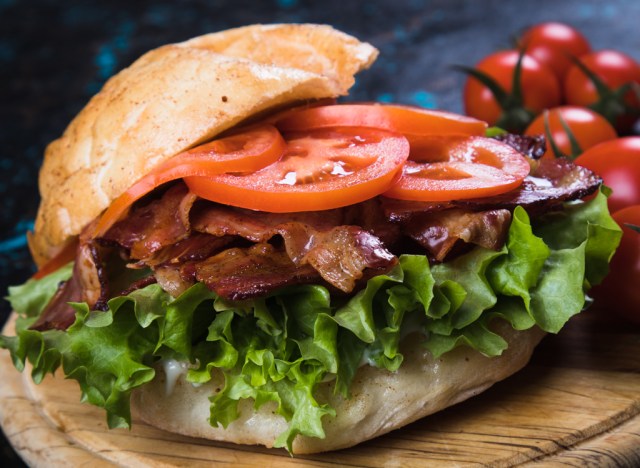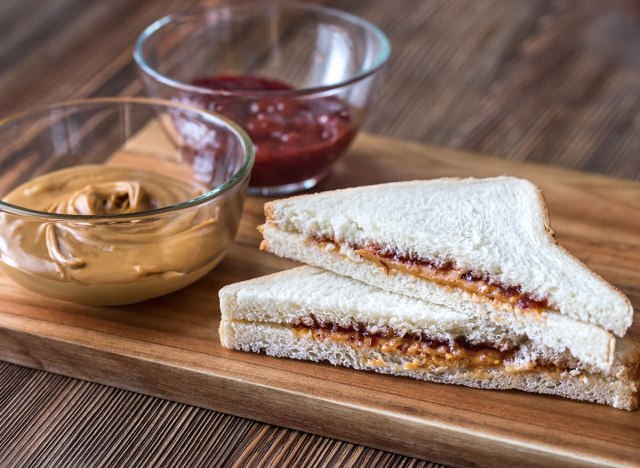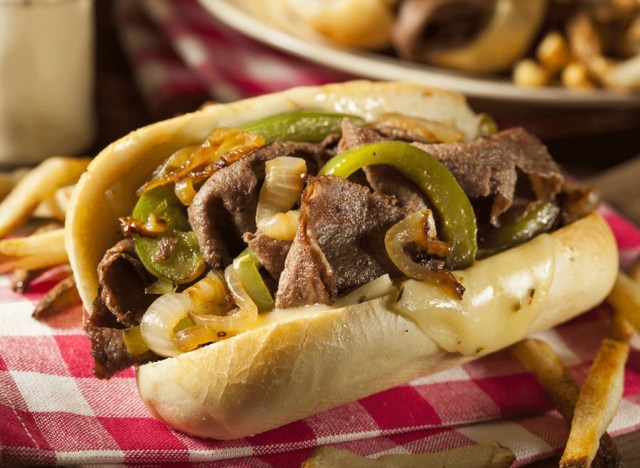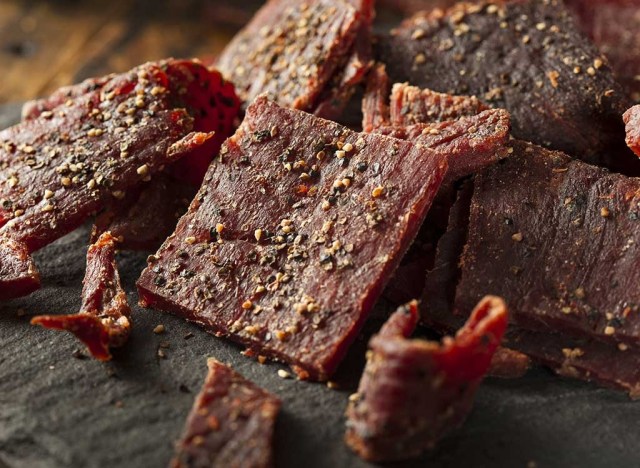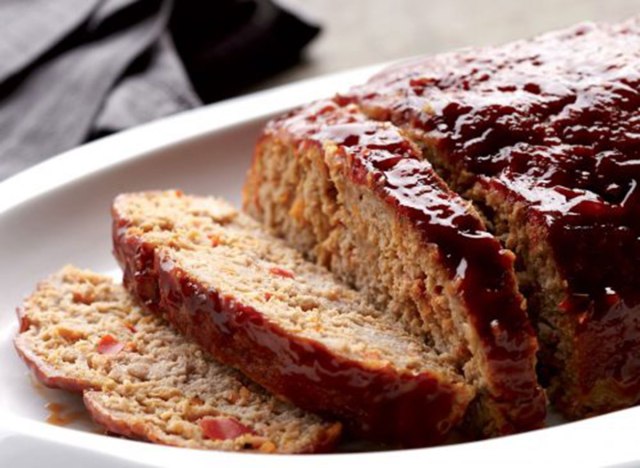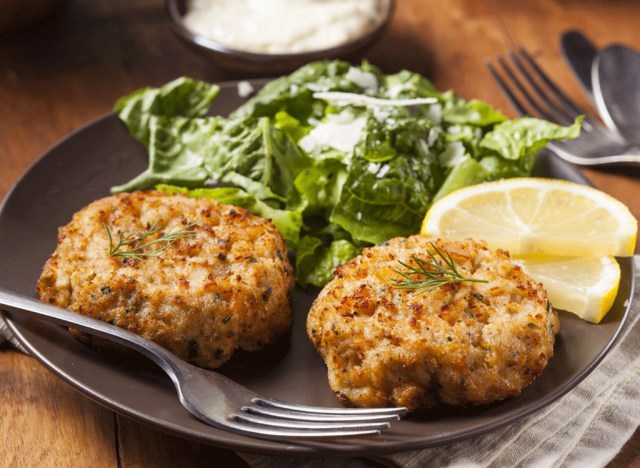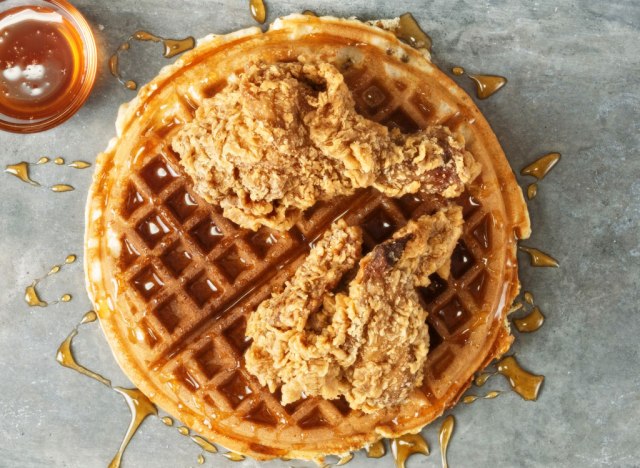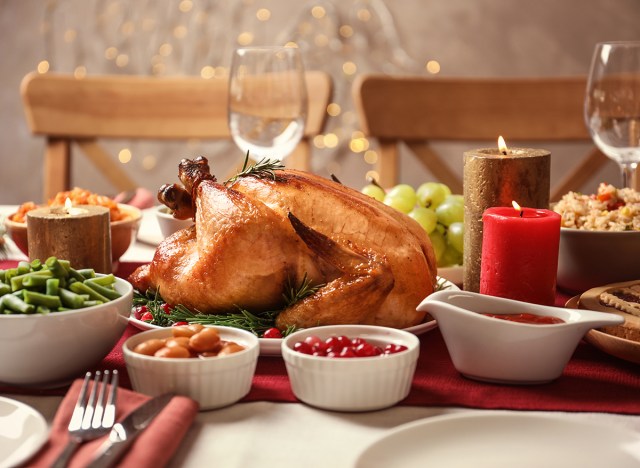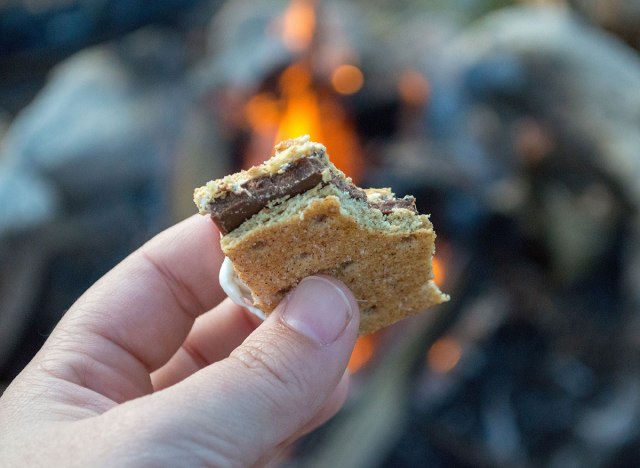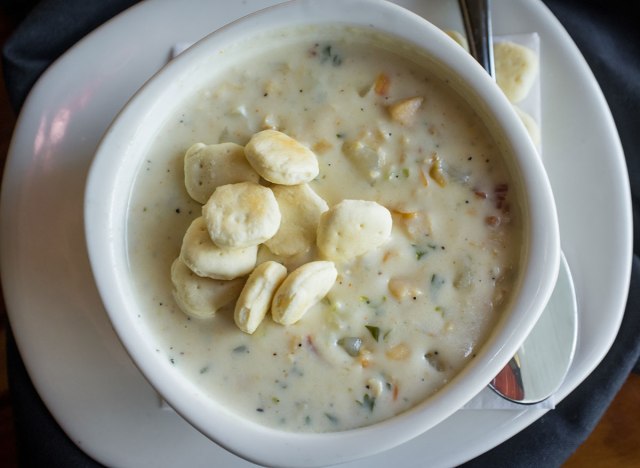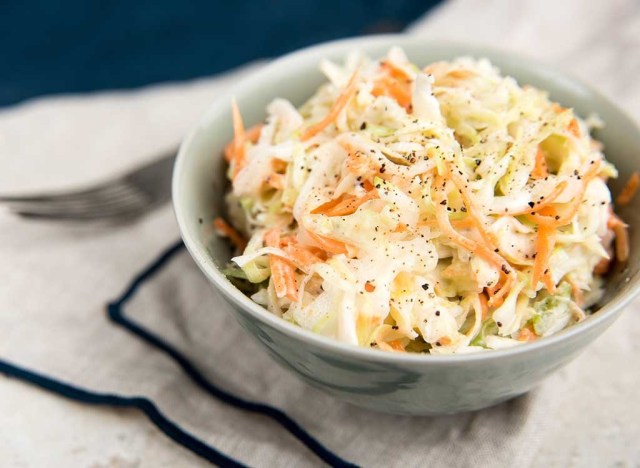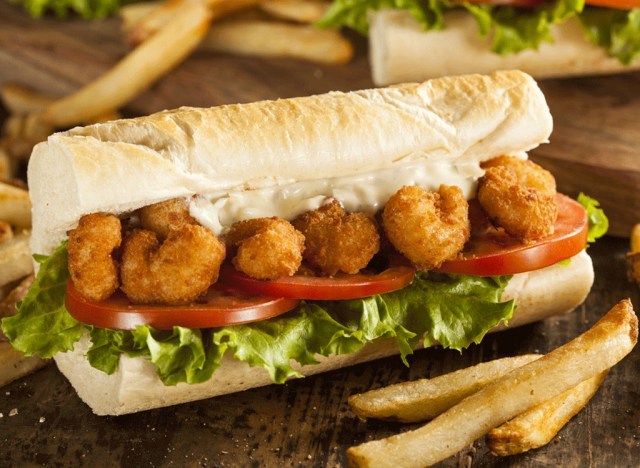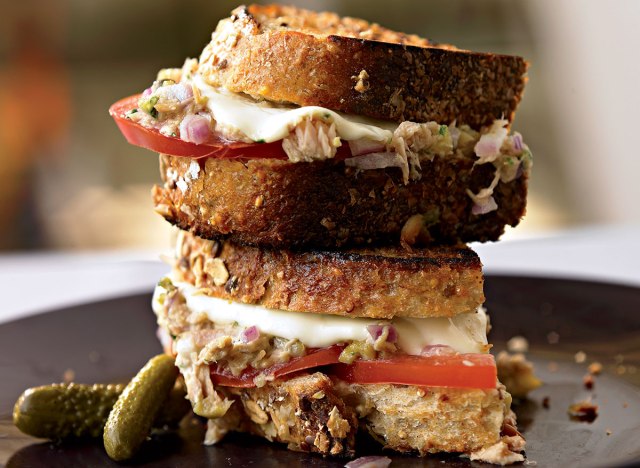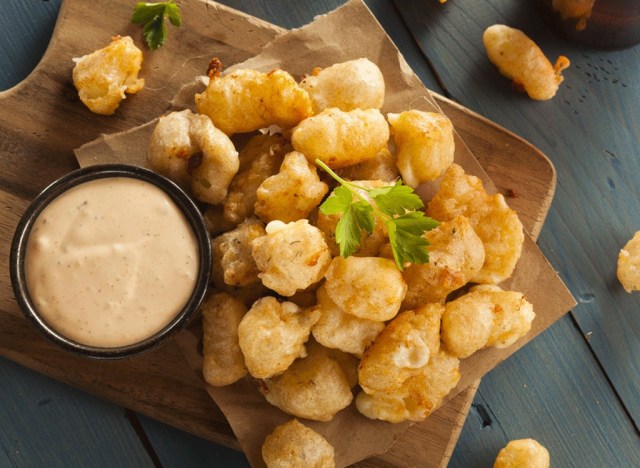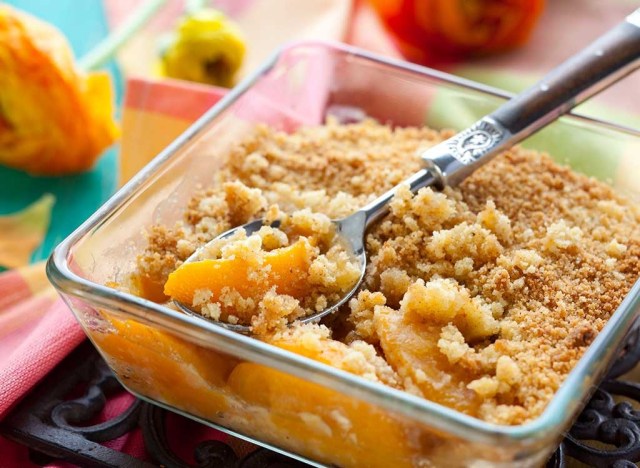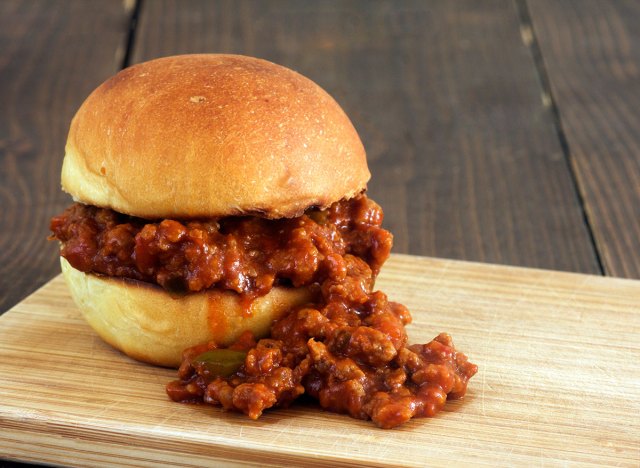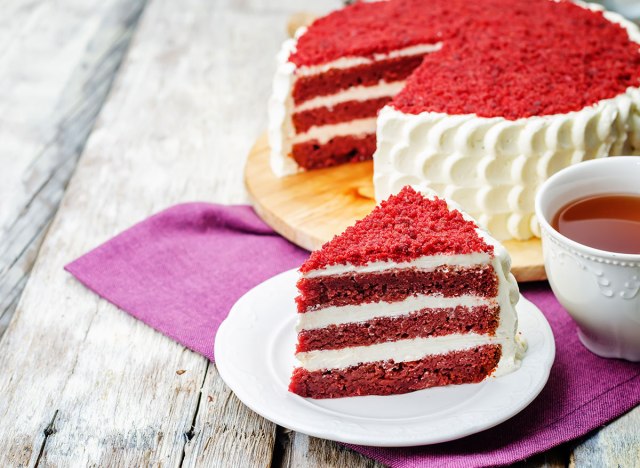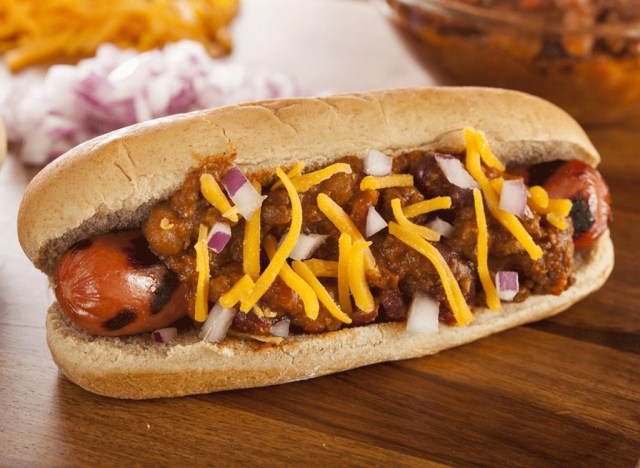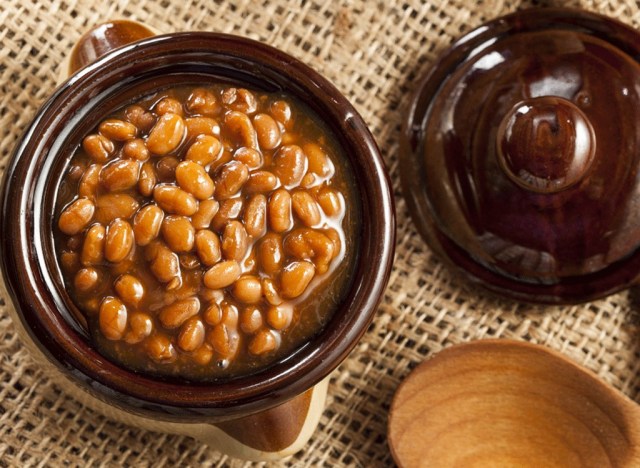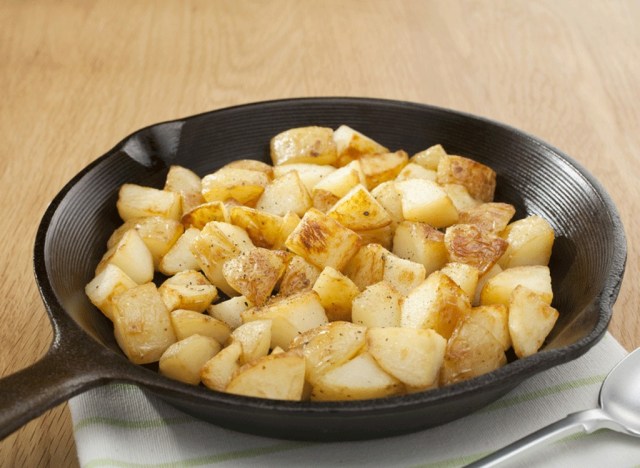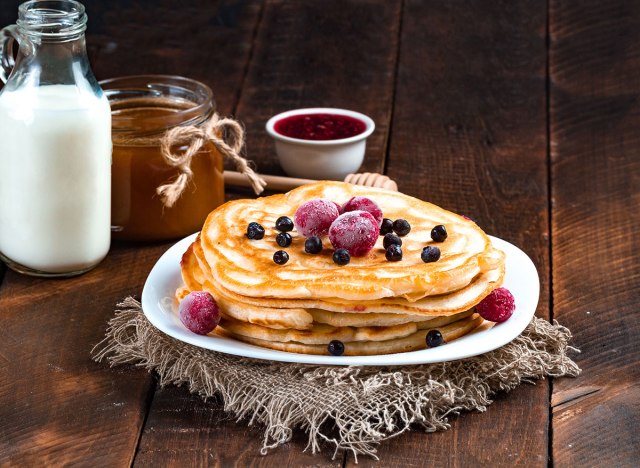50 Beloved Meals People Love
While trying new foods is nothing short of exciting, there is something about the classics. Go ahead, let your mind reminisce on all of the beloved, traditional foods you grew up savoring—like burgers, macaroni and cheese, and ribs. If you’re salivating by just the sound of this description, this master list of classic American foods is the challenge you’ve been looking for. You might as well add them to your bucket list of foods to try—why not?
We’ve compiled 50 cherished American foods everyone from coast to coast loves, along with some fascinating history about each. (Admittedly, not every food is from America, but we’ve come to see them as American staples!) And for more, check out these 15 Classic American Desserts That Deserve a Comeback.
Hot dogs
“Take me out to the ballgame!” We’re kickstarting this list with the signature food of America’s favorite pastime; it’s no wonder why there’s a brand of hot dogs called Ballpark. The hot dog is said to have gotten its name from a cartoonist for the New York Journal named Tad Dorgan in 1901. He hastily sketched the scene from the New York Polo Grounds that showed vendors launching hot dogs from hot water tanks yelling, “They’re red hot!” These hot dogs, however, were made out of sausage, whereas today’s hot dogs can be made from a myriad of different kinds of meat.
Not sure how to top your dog? Here are 16 Best Hot Dog Toppings.
Mac & cheese
You could go to an elegant restaurant and dine on a decadent bowl of creamy artisan cheese and handcrafted noodles, or you could make some classic Kraft mac and cheese right at home. While its exact origin is tricky to identify, the earliest known recipe for macaroni and cheese was written in 1769, according to Smithsonian. Thomas Jefferson is believed to have introduced it to the United States. While abroad in France, he was inspired by the plentiful pasta dishes offered there, so he brought back a few recipes and a pasta machine to boot. In 1802, the late president served the dish at a state dinner.
Cornbread
According to the USDA, more than 90 million acres of land are devoted to the cultivation of corn. Wow! Cornmeal is the primary component of the bread, and it pairs best with just about any meat, salad, and stew. It’s the perfect complement to heartier foods.
Corn dogs
The inception of the corn dog is accredited to the Fletcher brothers, Carl and Neil, who introduced Fletcher’s Corny Dog to the State Fair of Texas in 1942. With that, the perfect marriage of cornbread and the hot dog became an iconic meal in American history.
Apple pie
It’s no wonder this pie is a hit among Americans. Buttery, flaky homemade pie crust surrounds warm slices of baked apples, all of which are suspended in a sticky, sugary syrup with cinnamon. In 1902, an editor for The New York Times said, “Pie is the American synonym of prosperity. pie is the food of the heroic. No pie-eating people can be permanently vanquished.”
Despite such devout homage to the dessert, apple pie did not originate in the United States. The first apple pie was created in England during the 14th century. The term, “as American as apple pie,” became a commonplace term in the 1940s when the U.S. entered WWII and men reluctantly answered journalists’ questions why they were willing to go to war with, “for mom and apple pie.”
Try making this pie at home with our Best-Ever Apple Pie Recipe.
Buffalo wings
Buffalo chicken wings make a delicious asset to pub grub on game day, and the first wings were introduced by a family-owned joint called Anchor Bar in Buffalo, New York.
Chili
If you need to clear your sinuses, this savory bean and meat combo is your go-to; it packs quite a bit of heat. Chili is said to have originated in 1893 at the San Antonio Chili Stand in the World’s Fair in Chicago. By the beginning of the 20th century, chili joints popped up all over Texas and swept across the west by the 1920s. Not only was it incredibly delicious, but it was also cheap, which was advantageous during the Great Depression. Now that’s some food for thought!
Grilled cheese
Grilled cheese may just be the greatest thing since sliced bread. Otto Frederick Rohwedder introduced the U.S. to sliced bread in 1928 with his bread slicing machine. About 12 years before this, James L. Kraft patented processed cheese. During the Great Depression, toasted cheese sandwiches with tomato soup was a cheap meal to put together for a house full of kids.
Tater tots
Did you know that Americans consume more than 70 million pounds of tater tots per year? The tater tot came about in 1953, thanks to F. Nephi Grigg of Ore-Ida. Whether you eat them as a side dish or use them as the base of a casserole, tater tots are an American classic.
Lobster rolls
For many, lobster is a luxury item, with some fresh catches costing more than $20 per pound. However, it was the complete opposite in the 1600s and 1700s. According to Smithsonian, lobster was regarded as an ocean bug, and it was seen as a food that only the lower class and prisoners should enjoy. Lobsters were even used as a fertilizer if you can believe that. It was not until the 1800s that lobster prices—as well as a liking to eating it—increased.
And just so you know, here is where you can find The Best Lobster Roll in Every State!
California rolls
The California roll has a disputed origin. Three different chefs claim to have created the roll: Ichiro Mashita of Los Angeles, Ken Seusa of Los Angeles, and Hidekazu Tojo of Canada. Whoever created it first, it was widely known across the U.S. by the 1980s.
Cheeseburgers
Burgers are one of America’s most popular staples. With fast-food restaurants like McDonald’s, In-N-Out, Sonic, Wendy’s, and many more all having a glorified rendition of the cheeseburger, it explains why it’s become such an icon on the American menu. And nothing brings people together quite like a burger-flipping cookout in the backyard.
Baked Alaska
On March 30, 1867, the U.S. bought Alaska from Russia for two cents per acre, costing a total of $7.2 million. Chef Charles Ranhofer at Delmonico’s in New York is credited with inventing the igloo-shaped sponge cake, which encloses several layers of ice cream and is coated in fluffy, toasted meringue.
Gumbo
Gumbo is a Louisiana favorite, with the first pot of gumbo being served at a gubernatorial reception in New Orleans. Most variations include either seafood, chicken, sausage, as well as some greens and herbs. Next time you’re in New Orleans, make it a priority to try a steamy bowl of this long-lived Southern delicacy!
Grits
Grits were first popularized by Native Americans, who ground the corn into cornmeal, which they would then use to make porridge with.
Today, grits are one of the 35 Southern Dishes Your Grandparents Used to Make.
Ribs
Did you know there are several different styles of ribs, the names of which are dedicated to the city they were first made in? For example, there’s the Memphis-style dry rib, which is best made cooked over medium heat and charcoal. There’s also a St. Louis-style rib, which got its name from the way it was cut. The meat is stripped from the cartilage, rib tips, and sternum bone, which is why they look like little rectangles.
Wild Alaskan salmon
Glaze some butter or teriyaki sauce onto a filet of salmon and pair with a side of potatoes and sautéed broccoli for a delicious dinner.
Reuben
This classic, juicy sandwich contains a generous serving of corned beef and sauerkraut that’s been topped with a melted slice of Swiss cheese and smushed together by two plump pieces of rye bread.
Pot roast
Pot roast is pretty simple; all it consists of is browned meat with vegetables. This technique made its way into cookbooks in the late 19th century, but the method of braising (which is slow cooking in liquid) is something that has been around for centuries.
Key lime pie
Did you know that the Key lime pie may not have been invented in Key West after all? The first recipe for the pie was written in a Borden test kitchen in New York City in 1931.
Try your hand at making this American treat with our Easy Key Lime Pie Recipe.
Cobb salad
Bob Cobb, the owner of the now-shuttered Brown Derby restaurant in Hollywood in 1937, rummaged through his kitchen for a late-night snack. The ingredients that appear in the Cobb salad we see today reflect that of what he threw together to satisfy his midnight munchies.
Jambalaya
Similar to the Cobb salad, Jambalaya was made on a complete whim. As historians put it, a traveler arrived at a New Orleans inn several hours after dinner had been served, but the Inn’s cook threw something together for the exhausted man to feast on. And just like that, the dish of chicken, sausage, and/or seafood with an assortment of Creole seasonings, rice, bell pepper, onion, and garlic was born.
Biscuits ‘n gravy
This dynamic duo is the definition of Southern food. There’s meat, a thick and creamy sauce, and a plush biscuit all on one plate. What more could you want?
Onion rings
Ah, the onion ring, a classic substitution for the French fry. The earliest recipe dates back to 1802 with John Molland’s cookbook The Art of Cookery Made Easy and Refined. His recipe called for fried onions with Parmesan cheese. The next recipe did not follow until 1910 in the Middletown New Daily Times. It’s interesting how such a popular side dish today took a little over an entire century to gain popularity upon its inception!
Chicago-style deep dish pizza
Believe it or not, the Chicago deep-dish pizza was created as a means to cope with the economic shifts that were taking place during WWII. The ingredients for the pizza’s dough—wheat flour, corn oil, salt, and yeast—were not among the rationed foods. And thus, the deep dish was born.
Baffled by all the different pizza styles out there? Don’t miss these 15 Iconic Regional Pizza Styles, Explained.
Banana split
There is much debate around the topic of who exactly made the first banana split. The century-long question of whether it was David Strickler of Pennsylvania or E.R. Hazard of Ohio who was the first to introduce this classic sundae to the world is still lingering. Whether you’re pro Penn or Ohio, the ice cream recipe remains the same.
BLT
If you think about it, this is a very basic recipe, yet its origin is not as easy to uncover. Perhaps the most promising background story is that the sandwich is named after Chicago Tribune writer Bert L. Taylor (otherwise known as “BLT”) in 1941.
PB&J
Peanut butter became a hit in 1904 at the World’s Fair in St. Louis, but the first mention of a PB&J sandwich did not appear until the 1940s when the sandwich gained popularity in the United States.
Philly cheesesteak
A hot dog vendor in South Philadelphia named Pat Olivieri spontaneously decided to throw a slab of beef onto the grill one day. A taxicab driver supposedly caught a mere whiff of the aroma and asked if he could have a steak sandwich. Within days, cab drivers from all around the city were coming to Oliveri for his steak sammies.
Beef jerky
The group of people accredited to first cooking up beef jerky is torn between Native Americans thousands of years ago and an ancient Inca tribe called the Quechua in the 1500s. Regardless, it spiked in popularity when the Europeans began to migrate to North America because traders and explorers deemed it as an excellent way to receive an adequate amount of protein during their travels.
Meatloaf
The birth of meatloaf dates back as early as the 5th century in Europe, but it gained its American status during the Industrial Revolution when the meat grinder was invented. It proceeded to be an economically viable meal for families during the Great Depression as well.
Maryland crab cakes
In the late 19th century, only those along the coasts got to enjoy crab cakes, but today, crab meat is transported for those all over the U.S. to enjoy. Crabmeat, eggs, bread crumbs, milk, and seasoning are the main components in this tasty dish.
Chicken and waffles
This trendy dish has origins dating back as far as the ’30s. The dynamic duo of crisp, fried chicken and fluffy waffles with a drizzle of maple syrup was a signature dish at Well’s Supper Club in Harlem, New York. It’s not your traditional breakfast item, but the savory and sweet flavor combination just can’t be beaten.
Thanksgiving turkey
Abraham Lincoln declared Thanksgiving a national holiday in 1863, and nowadays, no T-Day is complete without a turkey!
Deviled eggs
Deviled eggs don’t have roots in the United States; the first mention of the dish came about in 61 C.E. in a Roman satirical fiction called the “Satyricon.” Regardless of their inception, deviled eggs are now a go-to appetizer in the United States today.
Want to make these protein bites for yourself? Try one of these 12 New Twists on Deviled Eggs That Are Deliciously Different.
S’mores
The first s’mores came about in 1927 when a recipe for “some mores” debuted in the magazine Tramping and Trailing with the Girl Scouts. Samoas and s’mores—the Girl Scouts of America have given us so much goodness.
New England clam chowder
Any gourmand is bound to love a heavier, predominantly cream-based soup such as lobster bisque or clam chowder. The clam chowder was first served in the United States in Boston’s Ye Olde Union Oyster House—which is the oldest operating restaurant in the nation—in 1836. With juicy bits of clam, butter, and heavy cream, you’ll feel full after just a small bowl of this rich chowder!
Potato salad
The origin of potato salad dates back to Spanish explorers bringing the dish over to Europe in the 16th century. The more Americanized version of the recipe, though, is a reflection of the way the Germans adapted the recipe. Today, potato salad is a go-to side dish for picnics, family get-togethers, graduation parties, tailgates, and many other casual and fun events. When was the last time you went to a backyard cookout or a picnic without it?
Coleslaw
Similar to potato salad, coleslaw was not invented by Americans, but rather by the Dutch. The word coleslaw is derived from the Dutch word “koolsla,” which means cabbage salad. Today, it’s often served alongside sandwiches and burgers, and it has become a summer cookout staple.
Po’ Boy sandwiches
When you hear “po’ boy,” does your mind instantly think of fried shrimp? Oddly enough, the first po’ boy was comprised of spare bits of roast beef that were doused in gravy. The word po’ boy came from “poor boy,” which caught on from restaurant owners and brothers Clovis and Benjamin Martin when they went on strike from streetcar driving in 1929. They created an inexpensive sandwich so that they could feed those who were also on strike, and the name came from workers crying up to the kitchen, “Here comes another poor boy!”
Corn on the cob
One of the best foods to chomp on at a state fair or festival is a juicy, crisp, and sweet corn on the cob. The origin of corn dates back to about 9,000 years ago, where it was first cultivated in Southern Mexico and Central America. Today, it is a must-have treat for Americans, especially during the summer cookout days.
Tuna melt
The first can of tuna hit the market in 1903, but it was not until post-WWII that recipes for tuna fish sandwiches popped up. Perhaps the first recipe ever recorded for the combination was produced by Irma Rombauer in her cookbook, Joy of Cooking, in 1946. On page 30, you will see the recipe for “Tuna Fish Sandwiches with Cheese,” which entailed broiling an open-faced tuna sandwich with tomatoes and grated cheese.
Cheese curds
The year was 1840 when Wisconsin began producing a copious amount of cheese, and there were 2,800 cheese factories within the state by the 1920s! Wisconsin pumps out more than two billion pounds of cheese per year, so it should be no surprise that it’s the state in which cheese curds originated. You can think of the cheese curd as premature cheese because unlike most varieties, it is not recommended to eat after it has aged. It’s best to eat this bite-sized nub fresh; it lets out a little squeak after your teeth have sunken into it, too! Of course, the cheese curd gains a bit more character once it has been deep-fried.
Peach cobbler
The cobbler is essentially an adaptation of the steamed puddings that the British adored but can be made with just about any type of fruit that’s enclosed around a thick crust. They were created by settlers who came to America and wanted to create recipes they ate at home, but couldn’t find all of the same ingredients. They became a hit dessert in the late 19th century, and cobblers are still an American fave.
Sloppy Joes
The Sloppy Joe has quite a few origin stories, with three different places claiming ownership for the recipe and name, according to Blue Apron.
First, there is a bar in Havana, Cuba, called Sloppy Joe’s which argues that its loose meat sandwiches were the first in the 1920s. Ernest Hemingway frequented this establishment during the Prohibition Era and encouraged a Key West bar owner to change the name of his spot to Sloppy Joe’s Bar, after the original. Now, Hemingway’s favorite location claims it was the one who Americanized the sandwich.
And yet, another (and widely accepted) claim comes out of Sioux City, Iowa’s Ye Olde Tavern. That story says it was a man named Dave Higgin who created the sandwich there in 1924. We may never know the truth.
Red velvet cake
The red velvet cake gets its origins from Victorian Era’s velvet cake, and legend has it that after the owners of the Adams Extract company out of Texas ate a velvet cake at the Waldorf-Astoria in New York City, they were inspired to replicate the recipe using their products. And it was in the 1940s that Adams Extract printed a red velvet cake recipe, which was a velvet cocoa cake with food coloring.
Coney dogs
This kind of hot dog has quite a special history. The Coney dog gained popularity throughout the eastern U.S. thanks to both Greek and Macedonian immigrants in the 1900s and 1910s. These dogs are smothered in tangy chili, onions, and mustard.
Baked beans
Baked beans might be a common favorite to pair with the hot dogs you’re busy grilling up, but they have Native American roots, originally being cooked with fat and maple syrup.
Home fries
Cubed, fried, and seasoned to utter perfection, these breakfast potatoes remain a classic across the country.
Bacon, eggs, and pancake breakfasts
Interestingly enough, bacon and eggs were deemed the “American Breakfast” in the 1920s after Sigmund Freud’s nephew helped the Beech-Nut Packing Company increase consumer demand for bacon. He turned to the company’s internal doctor, asking if a heavier breakfast was beneficial, and that doctor then asked 5,000 of his colleagues to confirm the hypothesis. This newfound “study” inspired Americans to eat a heavier morning meal to kick-start their day, and it’s no doubt that pancakes became the pair’s trusty sidekick shortly after.
The post 50 Beloved Foods Americans Love appeared first on .

